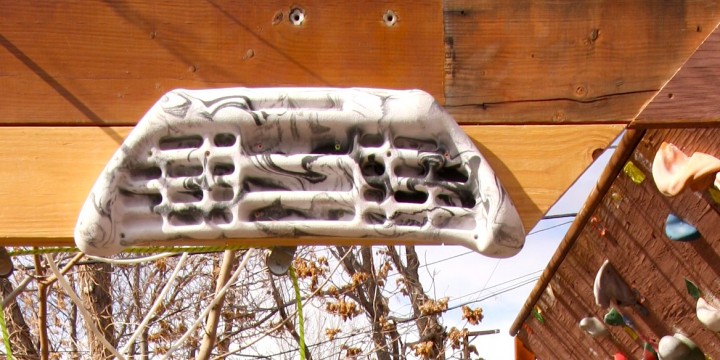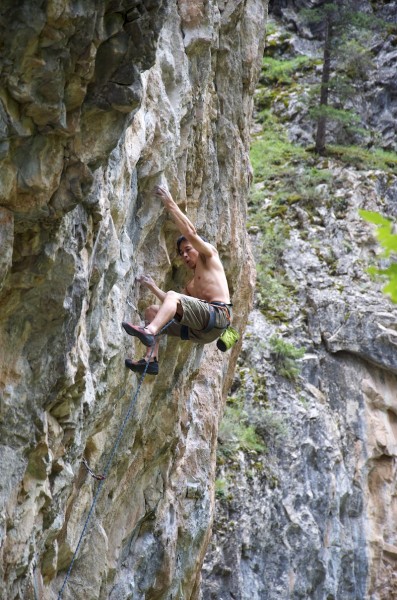
Hangboard Workout for Climbing: How and Why
Hi Steph,
First of all, let me say what an inspiration you are! I really enjoy hearing of all the things you and your husband do. I recently got a hangboard and want to take my training/climbing to the next step. I live about an hour away from the closest gym and further from the closest natural spot to climb, so I have to work out on a non-rock climbing gym. I have looked up numerous hangboard workouts and understand to stretch and warm up, but I was wondering if you had any tips on training for climbing without being extremely muscly. I feel from just pull ups, my biceps and arms are very large. While I admire strong women, I’d like to retain a little femininity. I have seen pictures of women climbers that are extremely bulky and also of ones that are very thin and feminine, yet very strong. Please don’t take this in an awkward manner, but from pictures I’ve seen, I consider you in the latter category. What do you do to stay top notch while still having a cute shape?
Thanks for your time,
Rebecca
Hi Rebecca,
Thanks! First I have to admit, I have never been able to get muscle-y, whether I want to or not (in college when I was into lifting weights, this was very annoying for me….as a climber, it seems pretty good). I’ve also noticed that I’m even less “bulky” since becoming vegan. However, it’s funny you ask about hangboard workouts, because I’m doing those right now for the first time, and it involves using the board without doing much in the way of pullups (I’m doing just a few sets of regular pullups and Frenchies to warm up). So this could be exactly what you’re interested in.
Personally I’ve never trained for climbing in the past–I considered climbing on my backyard wall and doing pull-up workouts to be training. I’ve always trained for projects on the routes themselves and have never lived somewhere where I had access to a real climbing gym or training facilities. But this winter I decided I wanted to find out more about “real” climbing training and give it a try. Though we don’t have a proper climbing gym in Moab, I do have a slowly evolving backyard training setup and a very helpful and kind friend from Rifle (as usual) named Kingsley who is into training. We were climbing up at the Cat Wall a couple of months ago, and I was telling Kingsley about my great new campus board. He got all interested and started asking questions about things I’d never even heard of….turns out he does periodization training, which means several weeks on a hangboard, then seguing into campus training, and then finally into systems training, for a total of about 2 months. And then he crushes for a while.
There is a lot of information out there, and there are many many ways to use these climbing training aids, as I’m sure you’ve noticed–for me, it’s too much information and I start getting a headache trying to figure out what to do and how. A great way to start is to find someone who’s been doing it for a while with good results and an understandable method, and just do exactly what they do for a phase–along the way, you’ll learn and start to figure out if there are any tweaks or changes you want to make. So that’s what I’m doing right now with Kingsley’s training system. I think it’s great, and I’m really psyched about it, 3 weeks in. I asked him to write his basic overview of what he does and why, to share with others here who might want to try it too. Then I’ll go through the steps of exactly how I got everything set up and got going as a newcomer to this workout in a second post (Hangboard Workout for Climbing, Getting Started) for those of you who have always been interested to try using a hangboard but didn’t really know where to start (I know I can’t be the only one!).

Here’s what Kingsley says:
I used to think that if I started training, which to me meant going to the gym twice a week and climbing at my limit, that my climbing would improve. Boy was I wrong. I started training because I was tired of getting injured. One summer, I dislocated my shoulder on a route that I had no business being on at the time. That’s when I decided to do something different with my climbing routine, and that’s when I learned that training doesn’t involve climbing. I encourage everyone to read an online article by Mike Anderson, “The Making of a Rockprodigy”, which laid the groundwork for the program that I use today. I’m more of a “tell me what to do and for how long” kind of guy, and he does a great job of that in his article of periodization. Since being more regimented, I’ve made letter grade improvements every year, onsighted higher grades than I previously redpointed, and have stayed relatively injury free.
My program is tailored more for people that don’t have a lot of time to dedicate to climbing but still want to improve. It involves hangboarding, campusing, and intervals on a systems board. All three compliment each other but if I had to pick just one, it would be the hangboard, and that’s where we’ll start. I used to train 7 different grips in one session (which was about 1.5-2 hrs long with a proper warmup) 2-3 times a week. That made for a very long workout and I also felt that my last 3 grips weren’t getting the same amount of attention as the first four. I now train 6 grips, 3 grips one day and the other 3 grips the next day, 4 times a week with the idea being to do just enough to get a reaction. The muscles aren’t broken down to the point where they require 2-3 days to recover. This makes for about a 45min workout. The 6 grips that I use are 2 finger pocket with team 3 (ring/pinky), 2 finger pocket with team 1 (index/middle), full crimp, open crimp, pinches and 2 finger pocket with team 2 (middle/ring). The workout consists of doing 3 sets of each grip, hanging for 7 seconds, resting for 3 seconds for 7 reps on the first set then reducing the number of reps by one each additional set with a 2 minute rest between each set. All set?
Typical workout:
3 sets for each grip
set one = 7 sec hang 3 sec rest x 7 reps
2 min rest
set two = 7 sec hang 3 sec rest x 6 reps
2min rest
set three = 7 sec hang 3 sec rest x 5 reps
2 min rest between grips
Typical week:
Sat/Sun = climb
Mon = rest
Tue = 3t, 1t, full crimp
Wed = open crimp, pinches, 2t
Thur = 3t, 1t, full crimp
Fri = open crimp, pinches, 2t
I use a pulley system with my hangboard which allows me to take weight off of myself on the harder holds. It’s also more accurate than putting your feet up on a chair. Keep a log of the amount of weight you use for each grip and how it felt. Instead of a stopwatch, I use a tabata timer from gymboss.com or you can download an app onto your phone. Set it up to beep at 3sec and at 7sec. You’ll notice your numbers will start to plateau after about 4-5 weeks. That’s a good time to move on to campusing.
Check back for the next post to find out how to set up your hangboard/pulley/weight pin system, how to set up your timer with an iphone, and how to start a training log.
Thanks Kingsley!








[…] outlined his method in the first hangboard post, and this here is you all you need to know to get set up to try it. Most climbing gyms have a […]
Hey Guys, My partner is a very good rock climber, so I have to do a lot of belaying. I was hurting my neck while belaying for long hours. So I bought Mike’s Belay Glasses from http://www.belayglass.com/ I wear these glasses and look forward to gaze upward saving on neck strain. They allow me to concentrate their attention to the task at hand, especially on long, protracted climb sessions. These glasses are cheap, roughly 1/4th the cost of the other belay glasses in the market. Check it out.
[…] you got motivated to start Kingsley’s hangboard workout and were able to get your whole setup organized and put together. Since I’m following his […]
[…] of installing a fingerboard at your house. Check out Eric Horst’s training book, and my posts about fingerboard training. What I like about Kingsley’s method (outlined in those posts) is that it allows you to […]
[…] took a simple workout plan from Steph Davis’ climbing blog. I decided on this one because it does not involve any pull-ups, just hanging. In the workout […]
[…] and we get some great days when it’s clear and sunny, but not always. I train by doing a hangboard workout, followed by campusing after several weeks, and then ideally finishing with systems. This is a 2-4 […]
[…] from tips on proper form to adding weight for additional intensity. Steph Davis also offers some great advice on hangboard training (along with an alternative hangs circuit), and this video from Chris Webb Parsons shows you how to […]
[…] READ IT HERE: Hangboard Workout for Climbing: How and Why […]
Difference between full and open crimp?
open crimp is with your fingers open and your thumb not engaged. Full crimp is with your thumb on the hold too (so your fingers are more bent).